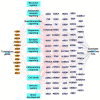Genetic Influences on Behavioral Outcomes After Childhood TBI: A Novel Systems Biology-Informed Approach
- PMID: 31191606
- PMCID: PMC6540783
- DOI: 10.3389/fgene.2019.00481
Genetic Influences on Behavioral Outcomes After Childhood TBI: A Novel Systems Biology-Informed Approach
Abstract
Objectives: To test whether genetic associations with behavioral outcomes after early childhood traumatic brain injury (TBI) are enriched for biologic pathways underpinning neurocognitive and behavioral networks. Design: Cross-sectional evaluation of the association of genetic factors with early (~ 6 months) and long-term (~ 7 years) post-TBI behavioral outcomes. We combined systems biology and genetic association testing methodologies to identify biologic pathways associated with neurocognitive and behavior outcomes after TBI. We then evaluated whether genes/single nucleotide polymorphism (SNPs) associated with these biologic pathways were more likely to demonstrate a relationship (i.e., enrichment) with short and long-term behavioral outcomes after early childhood TBI compared to genes/SNPs not associated with these biologic pathways. Setting: Outpatient research setting. Participants:140 children, ages 3-6:11 years at time of injury, admitted for a TBI or orthopedic injury (OI). Interventions: Not Applicable. Main Outcome Measures: Child behavior checklist total problems T score. Results: Systems biology methodology identified neuronal systems and neurotransmitter signaling (Glutamate receptor, dopamine, serotonin, and calcium signaling), inflammatory response, cell death, immune systems, and brain development as important biologic pathways to neurocognitive and behavioral outcomes after TBI. At 6 months post injury, the group (TBI versus OI) by polymorphism interaction was significant when the aggregate signal from the highest ranked 40% of case gene associations was compared to the control set of genes. At ~ 7 years post injury, the selected polymorphisms had a significant main effect after controlling for injury type when the aggregate signal from the highest ranked 10% of the case genes were compared to the control set of genes Conclusions: Findings demonstrate the promise of applying a genomics approach, informed by systems biology, to understanding behavioral recovery after pediatric TBI. A mixture of biologic pathways and processes are associated with behavioral recovery, specifically genes associated with cell death, inflammatory response, neurotransmitter signaling, and brain development. These results provide insights into the complex biology of TBI recovery.
Keywords: behavioral outcomes; genetics; pediatrics; systems biology; traumatic brain injury.
Figures





Similar articles
-
Applying Systems Biology Methodology To Identify Genetic Factors Possibly Associated with Recovery after Traumatic Brain Injury.J Neurotrauma. 2017 Jul 15;34(14):2280-2290. doi: 10.1089/neu.2016.4856. Epub 2017 May 3. J Neurotrauma. 2017. PMID: 28301983 Free PMC article.
-
Influence of Dopamine-Related Genes on Neurobehavioral Recovery after Traumatic Brain Injury during Early Childhood.J Neurotrauma. 2017 Jun 1;34(11):1919-1931. doi: 10.1089/neu.2016.4840. Epub 2017 Mar 21. J Neurotrauma. 2017. PMID: 28323555 Free PMC article.
-
Cumulative Influence of Inflammatory Response Genetic Variation on Long-Term Neurobehavioral Outcomes after Pediatric Traumatic Brain Injury Relative to Orthopedic Injury: An Exploratory Polygenic Risk Score.J Neurotrauma. 2020 Jul 1;37(13):1491-1503. doi: 10.1089/neu.2019.6866. Epub 2020 Mar 11. J Neurotrauma. 2020. PMID: 32024452 Free PMC article.
-
Genetic Influences on Patient-Oriented Outcomes in Traumatic Brain Injury: A Living Systematic Review of Non-Apolipoprotein E Single-Nucleotide Polymorphisms.J Neurotrauma. 2021 Apr 15;38(8):1107-1123. doi: 10.1089/neu.2017.5583. Epub 2019 Jun 7. J Neurotrauma. 2021. PMID: 29799308 Free PMC article.
-
Topical review: negative behavioral and cognitive outcomes following traumatic brain injury in early childhood.J Pediatr Psychol. 2015 May;40(4):391-7. doi: 10.1093/jpepsy/jsu093. Epub 2014 Oct 22. J Pediatr Psychol. 2015. PMID: 25342645 Free PMC article. Review.
Cited by
-
Dopamine-Related Genes Moderate the Association Between Family Environment and Executive Function Following Pediatric Traumatic Brain Injury: An Exploratory Study.J Head Trauma Rehabil. 2020 Jul/Aug;35(4):262-269. doi: 10.1097/HTR.0000000000000564. J Head Trauma Rehabil. 2020. PMID: 32108714 Free PMC article.
-
The genetic basis of inter-individual variation in recovery from traumatic brain injury.NPJ Regen Med. 2021 Jan 21;6(1):5. doi: 10.1038/s41536-020-00114-y. NPJ Regen Med. 2021. PMID: 33479258 Free PMC article. Review.
-
Systems Biology Guided Gene Enrichment Approaches Improve Prediction of Chronic Post-surgical Pain After Spine Fusion.Front Genet. 2021 Mar 23;12:594250. doi: 10.3389/fgene.2021.594250. eCollection 2021. Front Genet. 2021. PMID: 33868360 Free PMC article.
-
Brain-Derived Neurotrophic Factor Val66Met and Behavioral Adjustment after Early Childhood Traumatic Brain Injury.J Neurotrauma. 2022 Jan;39(1-2):114-121. doi: 10.1089/neu.2020.7466. Epub 2021 Apr 13. J Neurotrauma. 2022. PMID: 33605167 Free PMC article.
-
Brain-derived neurotrophic factor Val66Met and neuropsychological functioning after early childhood traumatic brain injury.J Int Neuropsychol Soc. 2023 Mar;29(3):246-256. doi: 10.1017/S1355617722000194. Epub 2022 Apr 25. J Int Neuropsychol Soc. 2023. PMID: 35465864 Free PMC article.
References
-
- Achenbach T. M., Rescorla L. A. (2001). Manual for ASEBA School-Age Forms & Profiles. Burlington, VT: University of Vermont, Research Center for Children, Youth, & Families.
Grants and funding
LinkOut - more resources
Full Text Sources

